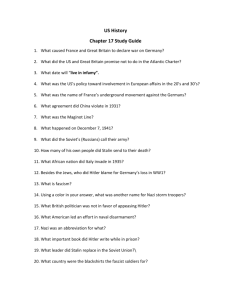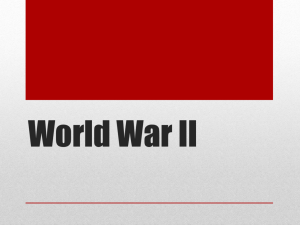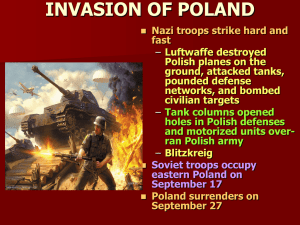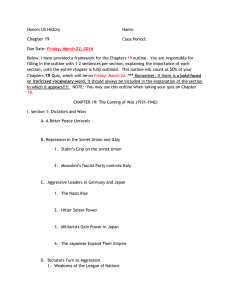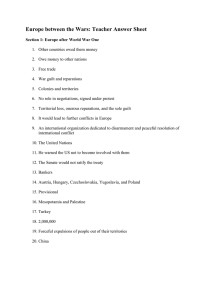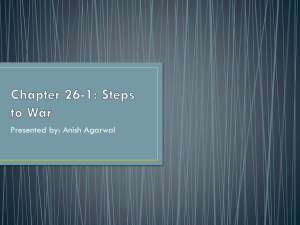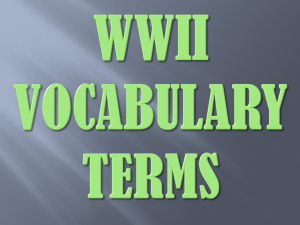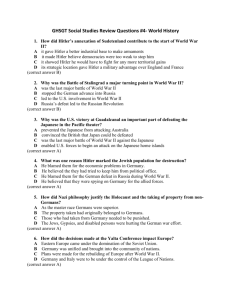9.2 Axis Powers Advance
advertisement
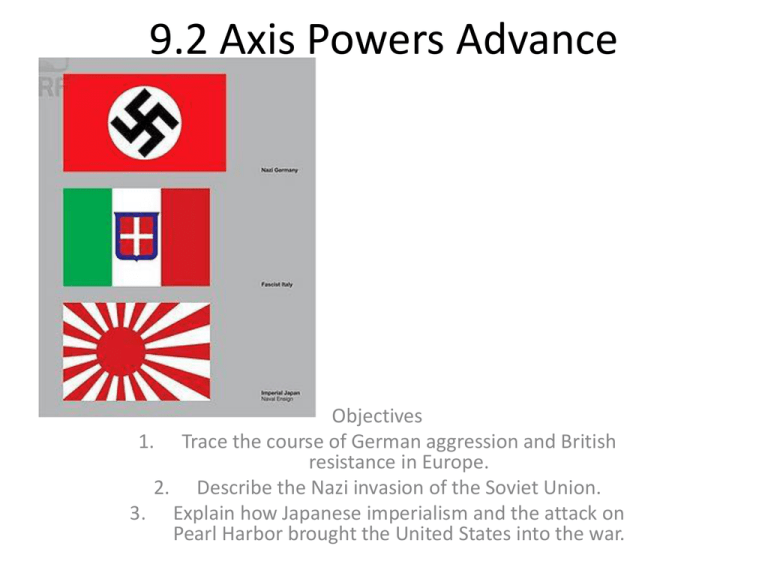
9.2 Axis Powers Advance Objectives 1. Trace the course of German aggression and British resistance in Europe. 2. Describe the Nazi invasion of the Soviet Union. 3. Explain how Japanese imperialism and the attack on Pearl Harbor brought the United States into the war. First Objective •Trace the course of German aggression and British resistance in Europe. Germany’s Lightning War • Nazi invasion of Poland revealed power Blitzkreig. – Lightning war – First, Luftwaffe or German air force, bombed airfields, factories, towns and cities. – Then, tanks would move in swiftly. Continued… • Germany attacked from the West. • Stalin’s forces invaded from the East. – Within a month, Poland did not exist as a country. – Everything happened so fast, the Brits and French couldn’t do anything. Continued… • In April 1940, Hitler launched a Blitzkrieg against Norway and Denmark. • Next he slammed into the Netherlands and Belgium. The Rescue at Dunkirk • In May 1940, German forces surprised the French and British by attacking through the Ardennes Forest in Belgium. – Bypassed the Maginot Line – Poured into France – Retreating British forces were soon trapped between the Nazi army and the English Channel. • British sent all naval vessels, merchant ships, fishing and civilian boats. • Rescued 300,000 troops. France Surrenders • June 22, 1940 France surrenders after being invaded from the North by the Nazis and from the South by the Italians. • Hitler forced the French to sign the surrender documents in the same railroad car in which Germany had signed the armistice ending WW1. – Germany occupied northern France – In the south, the Germans set up a “puppet state.” Operation Sea Lion • Britain stood alone in Western Europe. • Winston Churchill replaced Neville Chamberlain as Prime Minister. – Hitler was sure he would sue for peace but Churchill proved otherwise. • Faced with this defiance Hitler decided to invade Britain. – Launched massive air strikes that occurred daily. • Bombed South for a whole month • Then bombed London and other cities England Survives the Blitz • September 7th, 1940 German bombers appeared over London. • Bombing continued for 57 nights then sporadically until May. • Bombings known as “the Blitz.” – Citizens carried on their lives. – Churchill and the British King and Queen joined Londoners in bomb shelters. Hitler’s “New Order” • “New Order” grew out of racial obsessions. • Set up puppet governments in Western European countries that were peopled by light-skinned “master race.” – Slavs were considered inferior • Nazis stripped conquered nations of their works of art, factories, and other resources. • Resistance was met with savage revenge, shooting hostages and torturing prisoners. War in North Africa and the Balkans • Axis armies pushed into N. Africa and the Balkans. • September 1940, Mussolini ordered forces from Italy’s North African colony of Libya into Egypt. • The British pushed off the attack. • Hitler sent in Erwin Rommel or “Desert Fox.” – Pushed British back across the desert toward Cairo. – By 1941, the Axis Powers and their allies controlled most of Europe. OBJECTIVE REVIEW • Trace the course of German aggression and British resistance in EUrope NEW OBJECTIVE • DESCRIBE THE NAZI INVASION OF THE SOVIET UNION Nazis Attack the Soviet Union • After failing to take over Britain, Hitler turned his aggression onto the Soviet Union aka Russians (mistake). • June 1941, Hitler broke the Nazi Soviet Pact by invading the Soviet Union in Operation Barbarossa. – Hitler wanted • “living space.” • To conquer Europe and Northern Asia • Crush Communism A Rapid Advance • 3,000,000 German soldiers invaded the Soviet Union. • Germans caught Stalin off guard because his army was still suffering from purges that wiped out top officials. – 2,500,000 Soviets were killed. – Soviets destroyed factories, farm equipment and burned crops so the Germans couldn’t use them. – Germans were poised to capture Moscow and Leningrad (St. Petersburg). Kremlin or citadel Winter Halts the Blitzkrieg • The German advance stalled before Moscow and Leningrad. • Winter set in and temperatures plunged to 0 degrees. – The cold killed many, German troops set out in the summer and had no warm winter uniforms. – Fuel froze in tanks. – Mechanized equipment was useless. – Thousands starved or froze to death. Siege of Leningrad • September 1941, the two and half year siege of Leningrad began. • Food was rationed to two pieces of bread per day. – Desperate people ate almost anything. – Boiled wallpaper scraped off walls because its paste was said to contain potato flour. – Almost 1,000,000 Leningraders died, but the city did not fall. • British and Soviet Union agreed to work together. OBJECTIVE REVIEW/PDN 3.10.16 • Describe the Nazi invasion of the Soviet Union. NEW OBJECTIVE • Explain how Japanese imperialism and the attack on Pearl Harbor brought the United States into the war. U.S. Involvement in the War • When WW2 began US declared neutrality. – FDR found ways around their neutrality acts to aid Britain in its fight against Hitler. • March 1941, FDR persuaded Congress to pass the Lend-Lease Act. – Allowed FDR to sell or lend war materials to countries fighting for democracy. Continued… • August 1941, Churchill and FDR secretly met on a warship and issued the Atlantic Charter which set goals for the war. – Destruction of the Nazi Party – Protection of peoples seeking democracy – Permanent system of general security. Growing Tensions with Japan • In 1940, Japan advanced into French Indochina and the Dutch East Indies. In response, the United States banned the sale of war materials, such as iron, steel and oil, to Japan. – Japan felt threatened – General Hideki Tojo, later PM, was an extreme militarist who felt the United States was interfering with Japanese expansion plans. The Attack on Pearl Harbor • US and Japan held talks but they were at a standstill. • Tojo ordered a surprise attack. – December 7th, 1941 Japanese airplanes bombed the American fleet at Pearl Harbor in Hawaii. – 2400 lives lost – Battleships and aircrafts destroyed. – FDR – “A day that will live in infamy.” • Asked congress to declare war on Japan. • December 11th, Germany, Italy and Japan declared war on USA. Japanese Victories in the Pacific • Following Pearl Harbor, European possessions in the Pacific fell one by one to the Japanese. – Philippines (US) – Hong Kong – Burma – Malaya British Continued… • By 1942, the Japanese empire stretched from Southeast Asia to the western Pacific Ocean. – Japanese killed and tortured civilians in the Philippines, Malaysia and elsewhere. – They seized food crops – Destroyed cities and towns – Made locals into slaves Objective Review • Explain how Japanese imperialism and the attack on Pearl Harbor brought the United States into the war.


